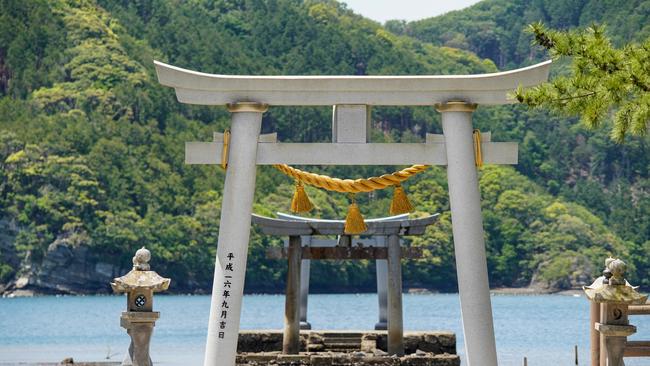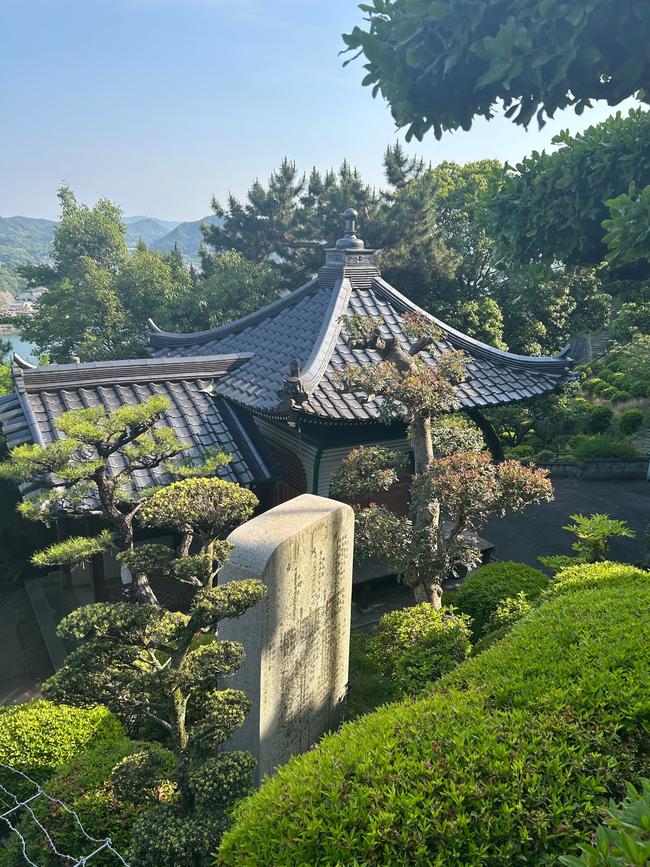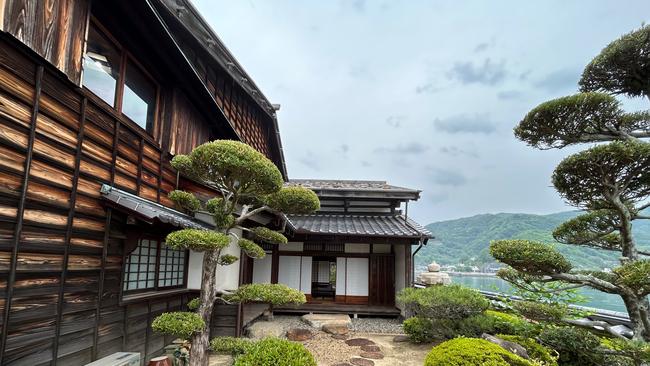Japan travel: cruise to Seto Inland Sea
An expedition voyage through the Seto Inland Sea shows how communities in decline can be revived with a creative kiss of life.

The towering brick chimneys on the island of Inujima reach towards a cloudless sky. One is a crumbling skeleton, fractured by time and neglect; another is cloaked in vines untouched by smoke for decades. It’s hard to imagine this 50ha dot in Japan’s Seto Inland Sea was home to 6000 people during its heyday. It was a time when granite was in such demand for construction that quarrying irrevocably altered the topography of the island, and a copper refinery belched fumes so toxic plants withered and died.
These days, only about 20 people live permanently on Inujima in a quaint village where many of the timber cottages are slowly succumbing to the elements. Reminders of the smelter are everywhere, in ruins of heavy black bricks created from slag via a strange alchemy of iron and glass. But the grass and trees have returned, the ocean is sparklingly clear, and black kites wheel overhead.

If you were wanting a symbol of Japan’s voracious industrial growth during the early 20th century and its subsequent decline and depopulation, Inujima would fit the bill. It is also part of a remarkable movement giving remote communities a creative kiss of life. Best known of these “art islands”, clustered between Honshu and Shikoku west of Osaka, is Naoshima. With its multiple museums and artist Yayoi Kusama’s famous yellow and black pumpkin sculpture a social-media magnet, Naoshima attracts art lovers from all over the world, especially during the Setouchi Triennale festival. In contrast, Inujima flies under the radar despite its quirky outdoor exhibits and a remarkable museum installation that takes visitors down a dark, sensory labyrinth.


“This is probably the world’s most spectacular example of revitalisation using contemporary art,” says renowned author Alex Kerr on the first night of Ponant’s inaugural expedition sailing through the Seto Inland Sea. Kerr, a longtime Japan resident and all-round expert on the country’s culture and art, is an engaging guest speaker on the eight-day voyage from Osaka to Fukuoka on Kyushu. He has devoted decades to genkai shuraku or “villages at the edge”; those at risk of becoming ghost towns as their residents age. Drawing on the experience of renovating his own home on Shikoku, he has helped to restore about 40 traditional dwellings. By saving these timber abodes, and adding the mod-cons considered essential to 21st-century life, younger generations can be lured back to have families and set up cafes, guesthouses and boutiques.
READ MORE:Traditions surive and thrive on Kyushu | A luxury cruise around Japan | On the path of the shoguns | The future of the Australia-Japan alliance | World’s best small hotels |
When Ponant expedition leader Ryo Ijichi was charting the itinerary for the luxury French cruise line, a major motivating factor was which communities had the most to gain from a ship visit. He spent much of Japan’s long Covid-induced isolation crisscrossing these benign waters, meeting mayors, appeasing fishermen with copious quantities of sake, and writing submissions to government. As our Zodiac glides into Tomonoura, Japan’s last surviving port from the Edo period (1603-1867), it feels as though his hard work has paid off.
Saved from a highway project’s wrecking ball in a David-and-Goliath legal battle 15 years ago, Tomonoura appears much as it has for centuries, replete with an old stone lighthouse once illuminated by candles. Metres from the harbour is the beautifully preserved former home of a wealthy sake merchant. Now a museum, it provides my first taste of not only the heady herbal concoctions knocked back as morning tonics, but of the peaceful ambience these dwellings exude. Sitting on a tatami mat, I look out over a meticulous garden; nearby, a kimono-clad musician plucks the delicate strings of a koto. Strolling the neighbourhood, I find Buddhist temples and Shinto shrines around every corner, their elaborately tiled roofs shining in the sunshine.


I’m not the first to be mesmerised by Tomonoura’s beauty. The town, like many we visit on this voyage, was a vital stop on the lucrative trade route between Korea and Japan. Rice, textiles, bronzeware, liquor and ceramics all passed through here for centuries on ships that would await a favourable tide before setting sail again. One Korean diplomat who called at Fukuzenji Temple in 1711 declared the outlook over Tomonoura Bay towards a forested isle topped with a pagoda the “most beautiful in Japan”.
Onomichi, on the other hand, has a much more industrial feel. The cable car that takes visitors up the peak that backdrops the city delivers views that prove Japan’s manufacturing hubs are never far away. The steep path that leads back downtown, however, takes us under leafy cherry trees that were a flurry of blossoms just weeks earlier. Temple and shrine devotees can tick off a total of 25 along the way. Nestled among massive boulders are racks hung with hundreds of inscribed wooden plaques and paper messages (omikuji); wishlists for wealth, health, love and good fortune.
Onomichi was once the centre for Japan’s rice trade. Nowadays, rental bicycles appear to be the commodity in demand. The city marks the starting point of the popular 70km Shimanami Kaido cycling trail that joins Honshu and Shikoku, crossing several Inland Sea islands on a spectacular purpose-built route. A hotel, dining and retail space, housed in a huge warehouse conversion on the Onomichi waterfront, provides a funky-industrial bolthole for this crowd. Here it seems an active lifestyle, not art, is luring a younger cohort from Japan’s thronging metropolises.

Each day our ship, Le Soleal, deposits us somewhere new, at times to a rock-star reception of town delegates, drummers and school kids excitedly offering gifts of origami. In some ports we are guided by Ponant expedition crew or local volunteers keen to explain the sights; in others we are handed a map and left to free range. The two approaches yield mixed results, especially for those who find the higgledy-piggledy lanes a challenge to navigate.
That’s no problem in Hagi, however, a city that stands on the Sea of Japan side of Honshu. We visit it en route to Yeosu in South Korea (foreign-flagged ships are required to visit one international port). Here, the castle came first and the streets were carefully designed in a neat grid around it. Compare a modern map of Hagi with one from the Edo period and, although the castle is long gone (the Meiji Restoration saw the dismantling of feudal power bases), little else has changed. It would be impossible to get lost here, but you could lose an hour or two browsing the gorgeous ceramics for which the city is famous.
Back on the Inland Sea, in Mitarai, I’d happily get lost and stay a few extra days. Delicate bouquets of flowers in bamboo flutes adorn timber houses with messages in kanji characters to welcome the cruise passengers. A young woman in a vibrant blue kimono performs a graceful Hanayagi dance accompanied by the three-stringed shamisen, like a box guitar. On the waterfront, a trio of musicians in silken robes extracts a mournful tune from woodwind instruments, including an intriguing reeded mouth organ called a sho. A young man invites passers-by into a toy museum founded by his father. It’s an extraordinary collection of dolls, action figures and retro board games, many in their original packaging, that conjures nostalgic memories of childhood.


We wander narrow lanes flanked by compact homes in varying states of repair. Some look well-loved, with bicycles parked beside thriving vegie patches, shoes lined up neatly by the door. Others are abandoned time capsules of family life coated in dust as the weather gradually takes its toll on roof and walls. I clamber up stone steps to a bonsho, one of the heavy bronze bells found at Buddhist temples. The nearby pavilion is a wreck – broken floorboards, torn lanterns and banners, a taiko drum spotlighted by the sun through an accidental skylight. Bedraggled o-mikuji are tied at the altar. What happened to all those hopes and dreams?
It’s sad to see such a state of decay yet Mitarai is a success story. It was granted protected status in 1994, and injections of government funds are helping to drive its renaissance. A new cafe is under construction during our visit, and there are galleries displaying modern art and pottery. Kerr tells me later that if it had a higher profile, Mitarai would be the poster child of civic renewal.
Meanwhile, Shimokamagari can be considered the island that started it all, well before that pumpkin was a gleam in Yayoi Kusama’s eye. This ancient port was an important stopover for Korean emissaries who would spend a year travelling from Seoul to Edo, modern-day Tokyo, and back via the Seto Inland Sea to cement commercial ties between the two countries. It is home to several museums and galleries, including the Shotoen Museum, which documents those extravagant trade shows of yore in incredible detail, right down to what their Japanese hosts had on the menu.

On Le Soleal, menus run the gamut from casual fare at Le Phyteas on Deck 6, where the chefs might load up buffet tables with seafood or a spread of French cheese; steaks, salmon and burgers can be made to order. L’Eclipse on Deck 2 is the fine dining venue where every evening meal begins with an amuse-bouche and main courses might include veal tenderloin with truffle sauce or buttery seabream with seaweed and clams. Passengers hoping to sample authentic Japanese cuisine may be disappointed in the sushi and teppanyaki offerings but this is an unashamedly French ship, with wines to match.
Of the 214 guests on board this outing, encompassing 19 nationalities, more than half are French speakers. Lectures alternate between that language and English, with crew showing an impressive mastery of both. When not exploring ashore or dining, I browse the bookshelves in the Panoramic Lounge or listen as the pianist tinkles Chopin and Schubert; some passengers sunbathe on the pool deck. As sunset approaches, I like to sip a gin and tonic on my stateroom balcony.
But as we sail into the fjord-like Aso Bay at the mountainous island of Tsushima, halfway between Japan and South Korea, there’s only one place to be – outside on deck. It’s the first time a cruise ship has called here but we could be the first human visitors, on any mode of transport. Almost 90 per cent of Tsushima is covered in vegetation, and there are few signs of habitation. It’s “green season”, or shinryoku, in Japan, when freshly unfurled leaves and grasses glow in the glorious spring sunlight before the onset of summer. Here, renewal is everywhere to be seen. No need to bring in the renovators.

IN THE KNOW
Ponant will conduct an eight-day expedition in the Seto Inland Sea from Kobe to Fukuoka departing March 30, 2024; from $10,690 a person, twin-share. The 184-passenger ship Le Jacques-Cartier will call at Inujima, Tomonoura, Onomichi, Shimokamagari, Miyajima, Hagi and Yeosu in South Korea, concluding in Fukuoka.
au.ponant.com
Penny Hunter was a guest of Ponant.


To join the conversation, please log in. Don't have an account? Register
Join the conversation, you are commenting as Logout